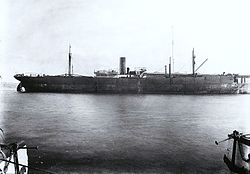Storstad (ship, 1911)
|
The Storstad after the collision in Montreal
|
||||||||||||||||||||
|
||||||||||||||||||||
|
||||||||||||||||||||
|
||||||||||||||||||||
The Storstad was a Norwegian coal freighter that collided with the Canadian liner Empress of Ireland on May 29, 1914 in the Saint Lawrence River . The resulting sinking of the Empress of Ireland killed more than a thousand people.
The ship
The Storstad ran on October 4, 1911 at the shipyard Armstrong Whitworth in Low Walker on Tyne with the hull number 824 from the stack and was established in January 1911, the shipping company A / S Maritim (AF Klaveness & Co.) in Christiania delivered in Norway. The steamship was 134.1 m long and 17.7 m wide, had a 7.5 m draft and was measured at 6,028 GRT .
The catastrophe
The Storstad , under Captain Thomas Andersen, was laden with coal on the way to Quebec when, in the early hours of the morning on May 29, 1914, she ran into a thick bank of fog in the Saint Lawrence River . At around two o'clock in the morning she rammed the Canadian liner Empress of Ireland northeast of the town of Rimouski . While the Empress of Ireland sank within fourteen minutes at the position 48 ° 36 ′ 0 ″ N , 68 ° 24 ′ 36 ″ W , the Storstad was damaged, but remained buoyant. After it was established that their own ship was not in danger, the crew lowered the boats and took in survivors of the Empress of Ireland . 1,012 people were killed in the accident; 465 were saved.
A later investigation blamed the crew of the Storstad for the disaster, as Alfred Toftenes, the first officer, changed course and did not inform the master about the fog. A further investigation by Norwegian authorities, however, came to the conclusion that the master of the Empress of Ireland was responsible for the accident, as he stopped his ship. Had he not done so, both ships would have passed each other without any problems.
The Storstad went after the accident on to Quebec, where he was first seized by the authorities, but later bought back by the previous owner and repaired.
Sinking
During the First World War , the Storstad was on March 8, 1917, with a load of maize on its way from Buenos Aires to Rotterdam , by the German submarine U 62 ( Kapitänleutnant Ernst Hashagen) at position 51 ° 20 ′ N , 11 ° 50 ′ W torpedoed and sunk 45 nautical miles southwest of Fastnet Rock off the Irish coast . Three men of the crew were killed.
literature
- Robert D. Ballard , Ken Marschall : Lost Liners - From the Titanic to Andrea Doria - the glory and decline of the great luxury liners . Wilhelm Heyne Verlag GmbH & Co., Munich 1997, ISBN 3-453-12905-9 (English: Lost Liners: From the Titanic to the Andrea Doria. The ocean floor reveals its greatest lost ships. Translated by Helmut Gerstberger).
- Ludwig Bühnau: Ships and their fate. A book about the adventure of seafaring. Arena Verlag Georg Popp, Würzburg 1968.
Web links
- The sinking of the Empress of Ireland on seefunknetz.de
- miramarshipindex.org.nz


